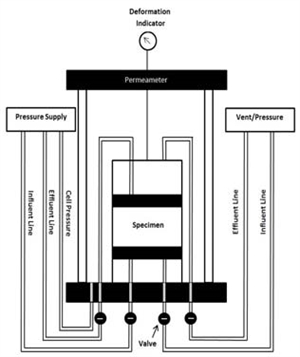BACKGROUND
Hydraulic conductivity is the key index to evaluate the effectiveness of GCLs as leachate barriers. The hydraulic conductivity test is conducted based on Darcy’s Law, and among all laboratory testing methods, we have adopted the constant head method in our research.
Constant head method requires the system to maintain constant hydraulic pressure, pressure should be measured and supervised during the test. The apparatus usually used in constant head testis shown in Fig.1.
In order to facilitate gas removal and saturation of the hydraulic system, four drainage lines are connected to the specimen, two to the base and two the top cap with valve controls. The specimen is mounted into the permeameter cell as shown in Figure 2. One sheet of filter paper should be placed between the top and bottom porous stones and the specimen to prevent intrusion of the material into the porous stones.
Flexible membrane is used to encase the specimen against the leakage. Rubber O‐rings should are used to provide adequate seal at the base and cap.
The hydraulic conductivity is calculated as follows:
Where: k = hydraulic conductivity, m/s Q = quantity of flow for given time t, taken as the average of inflow and outflow, m3 L = length of specimen along path of flow, m A = cross‐sectional area of specimen, m2 t = interval of time, S h = difference in hydraulic head across the specimen, m of water |

Fig. 1 Constant Head System
Fig. 2 Specimen Cell |